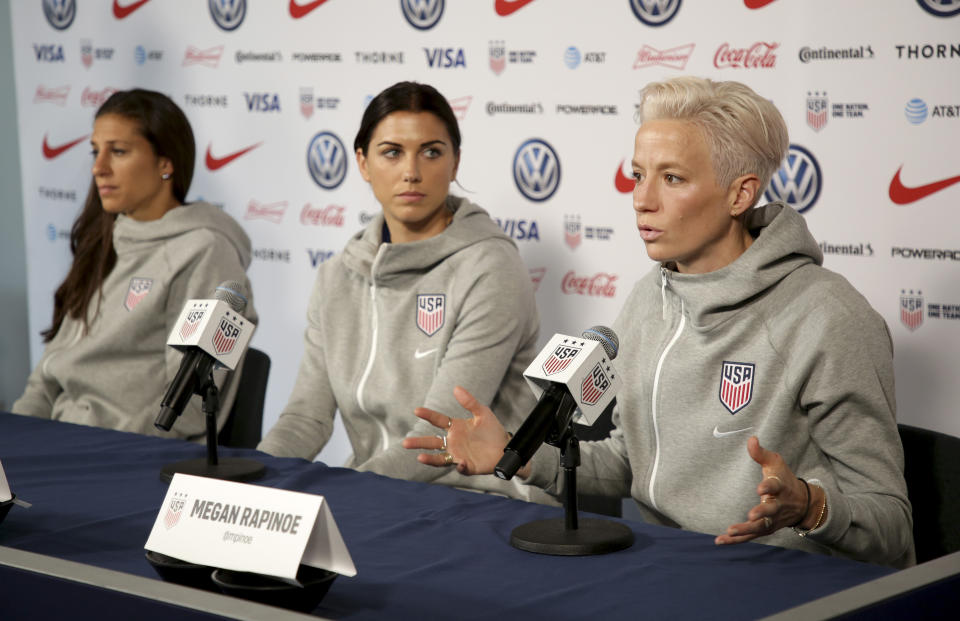USWNT argues stars earned less than one-third what men would if number of games — and wins — are equal

The plaintiffs for the United States Women’s National Team (USWNT) submitted a new court filing Monday in their pay discrimination lawsuit showing they would have earned nearly four times as much than their real compensation if they played under the men’s team’s structure.
The brief is a response to the U.S. Soccer Federation’s (USSF) filing last week opposing the team’s request to certify the lawsuit as a class action. The federation argued that the four players on the lawsuit — Alex Morgan, Megan Rapinoe, Carli Lloyd and Becky Sauerbrunn — each were paid “more than the highest-earning [men’s national team] members and therefore have suffered no injury” and shouldn’t represent the 28 players as a class.
USWNT disputes filing, argues total earnings invalid
U.S. Soccer included financial data in its filing showing the four players were each paid at least $1.1 million from 2014-19, out-earning the $993,967 paid to the highest-earning male player in the time.
The USWNT filed its brief arguing that basing the case on total earnings of each is invalid, per Graham Hays at ESPN. That’s because the women played more games than the men, had a higher winning percentage and won two world titles, lawyers are arguing.
Representatives of the players cite a federal court ruling involving the Equal Pay Act that posited the "absurd result" of such arguments would permit an employer to pay a woman half as much as a man, as long as she worked twice as many hours.
The women played 14 more matches dating from Jan. 1, 2017, to present. That includes the recent World Cup victory tour, which is written into the team’s CBA and is not part of the men’s team’s CBA. The women won 84 percent of their games in that span and the men won 48 percent. The time frame covers both World Cup competitions.
The filing argues, per ESPN: "The correct injury analysis is whether the plaintiffs would have earned more compensation under the pay rate policy of the MNT than they actually received under the pay rate policy of the WNT.”
USWNT would have earned nearly four times more
Lawyers for the women’s national team released figures showing how much the four players made under the women’s national team’s collective bargaining agreement and how much they would have made under the men’s CBA. The result is nearly four times as much if their earnings were the same structure.
Lloyd, the team’s highest earner, would have made $4,168,420.65 under the men’s CBA in comparison to the $1,204,049.64 she made from March 30, 2014, through Oct. 7, 2019, under the women’s CBA. That’s a paycheck 3.5 times larger.
By putting WNT players into MNT CBA, players, their union and their lawyers argue top stars would have made almost three times as much if they were MNT players. pic.twitter.com/y3M7uvezxg
— Andrew Das (@AndrewDasNYT) October 7, 2019
The financials kept out the pay each makes for playing in the NWSL; the plaintiffs argue it isn’t a part of the complaint that is focused on earnings while representing the national team.
"Women players on the U.S. National Team have the exact same job as men players," Molly Levinson, spokesperson for the plaintiffs, told ESPN. "And yet, a direct comparison shows that four of the top female National Team athletes were paid less than one third of what a male player would earn if he played in the same number of games and achieved the same record of success as the women players. This is the very definition of gender discrimination, which is illegal.”
Levinson said the U.S. Soccer Federation has “repeatedly tried to distort these figures” but “when the rates from the men's CBA are applied to each woman player's record and performance, the results show an unmistakably large pay gap."
Assumptions, falsehoods and the CBA
U.S. Soccer has maintained, per the Associated Press, that compensation and pay are based on the CBAs and are therefore different. The federation argues it’s an “equitable” deal.
The women, which signed their current one in 2017, have said they were rebuffed when asking for the same terms as the men. Their deal is a better one than those that preceded it.
Information about the ongoing lawsuit has also been rife with assumptions and falsehoods, as Caitlin Murray detailed for Yahoo Sports last week. There are no facts to support the assumption that the men’s World Cup brings in substantially more than the Women’s World Cup. FIFA bundles the two tournaments together for TV rights, sponsorships and the like so it’s impossible to pull apart the full value of either one.
More from Yahoo Sports:

